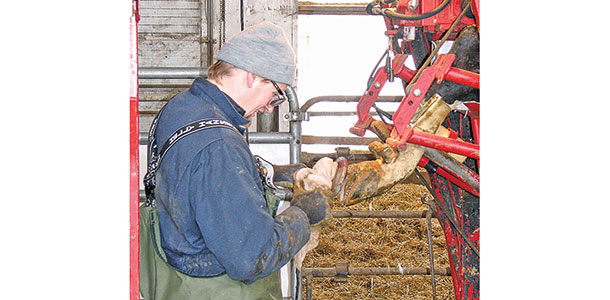It may be tempting to evaluate your hoof trimmer’s performance based on how fast he can wrap a foot or how quickly cows move through a chute, but Dr. Gerard Cramer, DVM, DVSc, encourages dairymen to expect more. As a veterinarian specializing in hoof health at the University of Minnesota Center for Dairy Health, Management and Food Quality, Cramer leads research efforts related to dairy cattle hoof care.
“The basic expectation is that trimmers should have the cow in mind,” says the associate professor. He advises dairymen to assess how well their trimmer is achieving this with a few basic observations. Cramer outlines seven “habits” to look for when selecting a hoof health professional.
1. There are no more lame cows after the trimmer has left. All cows should walk out of the chute better than they walked into it. If a cow wasn’t lame before trimming, she should not be tender for days or weeks afterward. Nor should new lame cows be showing up within the first three weeks following a trim.
2. Lame cows get better. Unless the environment is poor or the lesion is severe, most cows with lameness can be treated and recover at least to the point of being a salvageable cow. If a dairy is losing a large number of cows due to foot problems, treatment protocols should be questioned.
3. They are team players. Trimmers need to offer professional advice and be open to working with other members of a dairy’s team, such as veterinarians and nutritionists. The trimmer brings a valuable perspective to the table because he likely observes the cows on a routine basis and can note trends or changes. For example, at a team meeting, specific lesions may be correlated to the days in milk at which they occur.
4. Cleanliness is key. Though trimming can be a dirty job, a trimmer’s tools and equipment should be clean when he comes to the dairy. Various contagious cattle diseases can be transmitted from farm to farm via blood, manure and tissue found on hoof-trimming equipment. A quick visual inspection can indicate whether or not equipment has been cleaned between farm stops.

5. Good treatment records – beyond just the number of blocks and wraps. Tallying up the total blocks and wraps applied during the trimmer’s visit is good to know, but it doesn’t truly paint a picture of what may be going on in a herd.
Whether handwritten or documented in a computer program, more detailed information can be helpful in identifying problems or making diagnoses. A good record identifies the cow, date of trim, the actual problem (such as a lesion) and a diagnosis (sole ulcer, digital dermatitis, etc.).
6. They want to know more about your cows. A trimmer truly looking out for the best interest of the cow will ask questions of the dairyman. What is the environment where the cow is walking? Is it concrete or dirt?
Are stalls bedded with sand, shavings or straw? Where will the cow go after treatment? These environmental factors make a difference in determining how to treat a foot for the best shot at a successful outcome.
7. They want to know more, period. Ask your hoof trimmer about their education. Did they receive professional training? Did they attend a school or program to receive a certification? Are they pursuing further opportunities for continuing education through the Hoof Trimmers Association?
A successful trimmer-dairyman relationship falls on both parties. Cramer suggests that producers set clear expectations regarding record-keeping and trimming schedules. They should also provide the trimmer with feedback on how cows progressed following trims and treatments.
Keep in mind, however, that even the best hoof trimmer cannot fix foot issues that relate to poor management or inadequate environments.
“Trimming should be seen as a way to give the cow the best chance in her environment,” Cramer says. “If we do that right but have heat stress, overcrowding and poor beds, the best trimmer is going to struggle with lame cows and recovery.” PD
PHOTO
TOP: Dr. Gerard Cramer.
BOTTOM: With hands-on experience as a veterinarian specializing in hoof care, Dr. Gerard Cramer is leading foot health research at the University of Minnesota. Photos courtesy of Gerard Cramer.

Peggy Coffeen
Editor
Progressive Dairyman








